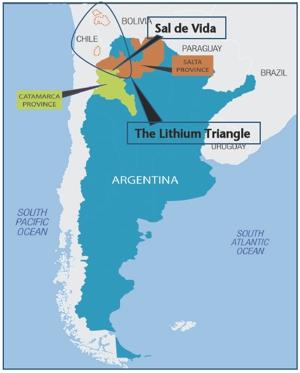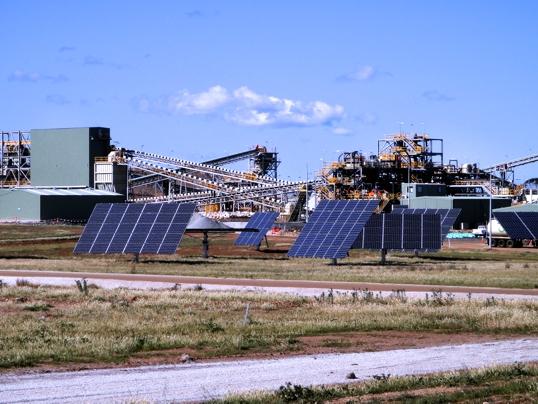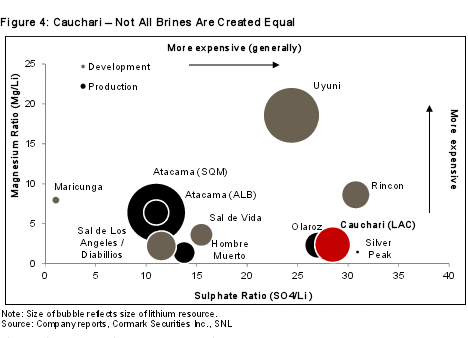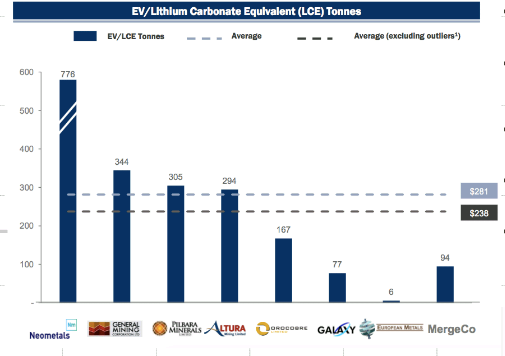Thanks
@apouse
here it is for the ones too lazy to click -
TLDR: valuation of GXY of $2.32 by 2020
Galaxy Resources - An Excellent Way To Invest Into The Lithium Miners
Summary
Sal de Vida is a very large, world class, low cost, lithium brine asset owned 100% by Galaxy.
Valuation metrics are all very positive suggesting further upside is warranted despite stellar recent gains.
The Sal de Vida updated DFS in July provides a strong short-term catalyst for the stock to be re-rated upwards.
Galaxy Resources (
OTCPK:GALXF) (ASX:GXY) - Price = USD 0.386, AUD 0.48
Galaxy Resources ("Galaxy") is an Australian mineral exploration company with a focus on the lithium sector.
Currently they have 3 lithium projects (100% owned) - Mt Cattlin Australia (spodumene producer), James Bay Canada (spodumene resource, DFS pending - late 2016), and Sal de Vida Argentina (brine resource, DFS update pending - July 2016).
Sal de Vida - location map
 Source
2016 off market takeover of General Mining [GMM]
Source
2016 off market takeover of General Mining [GMM]
In May 2016, Galaxy did a friendly off market takeover of General Mining offering GMM shareholders 1.65 Galaxy shares for each GMM share. The market viewed this favourably, I assume, as Galaxy will now have 100% share of future earnings, despite some equity dilution.
Galaxy's projects and resource details
Mt Cattlin Australia
The Mt Cattlin project is a restarted lithium spodumene mine located in Western Australia.
In a resource estimate issued in March 2011, Mt Cattlin's total contained lithium oxide (Li2O) resource was 197,000 tonnes, the measured and indicated resource was 13.8 million tonnes and total resource ore tonnes were 18.18 million. Tantallum is also produced. The current life potential of the Mt Cattlin mine is 18 years, including inferred resources.
Mt Cattlin processing plant with solar panels and wind turbines
 Source
James Bay Canada
Source
James Bay Canada
The James Bay lithium pegmatite project in Quebec, Canada contains indicated resources of 11.75 million tonnes (mt) grading at 1.30% Li2O and inferred resources of 10.47mt grading at 1.20% Li2O, making a total resource of 22.22mt.
Galaxy is currently progressing this project and is at the Definitive Feasibility Satge (DFS).
NB: Spodumene is typically found in lithium-rich pegmatites in association with other lithium minerals such as lepidolite, eucryptite and petalite. Pegmatites are formed by the crystallisation of post-magmatic fluids.
Sal de Vida
The Sal de Vida ("Salt of Life") is Galaxy's flagship project, located in Argentina. The deposit is one of the world's largest and highest quality, undeveloped lithium brine deposits with significant expansion potential.
The Sal de Vida is a sub-salar and forms a part of the larger Salar del Hombre.
Based on their 2013 DFS, they reported JORC-compliant reserves of:
Indicated - 1.048mt LCE at 768 mg/L
Total (indicated, measured and inferred) - 7.223mt LCE at 753 mg/L
This makes Sal de Vida one of the largest LCE resources globally.
It also has very good quality with very low magnesium and low sulphate concentrations. This helps to lower the cost of production. See chart below.
The 2013 DFS post tax value for Sal de Vida is USD 380m. Once the Sal de Vida DFS is updated in July this year, the net present value (NPV) is expected to move 2-3 fold higher, due to current higher LCE prices above 10,000/t (the 2013 DFS used LCE prices of USD5,500/t) and lower Capex due to a fall in the Argentinean peso. Additionally, the Argentine Government removed the 5% royalties on LCE. Managing Director Anthony Tse stated the new NPV could be expected to be "
north of a billion dollars." (link is to a video with Anthony Tse)
Comparison of the major lithium brines globally.
 Source
Production
Source
Production
Mt Cattlin
The Mt Cattlin lithium mine was re-opened on April 1, 2016, with a planned 2016 production of 60kt of spodumene, 150kt pa in 2017, and 200ktpa in 2018. 2016 off take agreements have been secured for the spodumene at USD 600/t. 2017 off take already secured for 120kt of production with prices to be set later in the year.
James Bay
The late 2016 DFS will give details regarding resource size, planned production, and life of mine.
Sal de Vida
Sal de Vida is anticipated to ramp up to 25ktpa of LCE by around 2020, assuming construction goes ahead, which is highly expected. First production is expected to be in 2019.
Valuation
Currently no PE, as earnings have only recently begun in 2016, making current earnings an inappropriate valuation method. Most analyst's current targets are above AUD 0.60. Strachan Corporate have a current sum of parts valuation of AUD
0.64 before factoring in the Sal de Vida updated DFS NPV.
Debt is around AUD
20m (as at March 16, Galaxy held approximately $8 million of cash and had a 3-year, $31 million debt facility with a 10% pa coupon), as management has restructured the company after the tough times. Management has a focus not to dilute equity.
Current market cap of the combined Galaxy and General Mining is around AUD 870m or USD 640m. This compares to Galaxy's main peer Orocobre (
OTCPK:OROCF) [ASX:ORE] on a market cap of AUD 974m, or USD 718m. Galaxy has a similar-sized Argentine asset to Orocobre, and a total of 3 projects globally so better diversified against country risk.
Galaxy has a low enterprise value/resource ratio comparing very favorably to their peers.
Enterprise Value/Resource (LCE) tonnes comparison
 Source
Source
The above chart shows the "MergeCo" being the merged company of Galaxy and General Mining, valued significantly cheaper (based on Enterprise Value divided by resource), than all of its ASX listed peers (excluding European Metals).
Sum of the parts valuation
|
Column 1 |
Column 2 |
Column 3 |
Column 4 |
| 1 |
|
|
|
|
| 2 |
NPV (post tax) ($US) (millions) with 2013 Sal de Vida DFS
|
|
|
|
| 3 |
Low estimate NPV (post tax) ($US) (millions) with 2016 "estimated" Sale de Vida update
|
High estimate NPV (post tax) ($US) (millions) with 2016 "estimated" Sale de Vida update |
|
|
| 4 |
Mt Cattlin |
235 |
235 |
235 |
| 5 |
James Bay |
18 |
18 |
18 |
| 6 |
Sal de Vida (2013 DFS) |
380 |
*755 |
1,200 |
| 7 |
Net Cash/tax benefit |
24 |
24 |
24 |
| 8 |
Total NPV (USD) (million) |
657 |
1,032 |
1,477 |
| 9 |
Total NPV(AUD)(million) |
880 |
1,382 |
1.979 |
Source: Strachan analysis (left column)
NB: I have summarized a sum of the parts valuation based on Net Present Value (NPV) for Galaxy Resources, and included a "low" and a "high" estimate of NPV, which includes the Sal de Vida update.
*The key takeaway is the huge "estimated" increase in Sa de Vida NPV due to be released in July. Also, James Bay will get an uplift expected to move to at least USD 59m (AUD
80m) after the DFS is completed in 2016/17. I have not included this for now.
Comparing the AUD NPV from the table above, and given the current pro-forma (Galaxy+General Mining) market cap of around AUD 870m, we can see the following:
"Low" estimate - Galaxy is 59% undervalued. Or Galaxy's market cap should soon reach AUD 1.382b.
"High" estimate - Galaxy is 127% undervalued. Or Galaxy's market cap should soon reach AUD 1.979b.
Valuation based on 2020 forecast production
My model forecasts a 2020 stock price for Galaxy of AUD 2.32 or around 4.4 x upside from today's price.
It assumes Mt Cattlin is producing 200ktpa of spodumene, James Bay is producing 150ktpa (to be adjusted after the DFS) of spodumene, and Sal de Vida's 66.5% share (25% estimated future partner to fund the mine cost, 8.5% Government share) of 25ktpa.
Should production exceed these levels, performance would be better and vice versa. Also assumes spodumene selling price of USD 700/t, cost price of USD 205/t, LCE selling price of USD 10,000/t, cost of production USD 2,500/t, and a P/E multiple of 15.
Note: Galaxy has very strong contacts in China and the current China contract price for LCE is around USD 13,000 /t.
Near-term catalysts
1) The Sal de Vida DFS is expected to be updated, according to the company, in early July. According to Anthony Tse (Managing Director at Galaxy), he expects the updated DFS to indicate an increased NPV by around
2-3 fold (or north of USD 1b). The Strachan analysis above was based on only about a 2x increase (to USD 755m), so was conservative; however, Strachan has also stated Sal de Vida's updated NPV may be "over USD
1.2b," or a 3x increase. (see page 5 of the link). Perhaps the USD 1.2b is pre-tax, whereas the USD 755m is post-tax.
2) The first earnings from the Mt Cattlin mine will soon be announced, as well as 2017 off take agreements and pricing. Tse expects a pricing uplift of 10-20% from the USD 600 current level.
3) The DFS for the James Bay Canada project is to be announced in late 2016 or early 2017.
Competitors
The other producing lithium miners, and soon to be producers. I have discussed these previously in detail
here,
here and
here. Needless to say, the top 3 producers are non-pure plays (SQM (NYSE:
SQM), Albermarle (NYSE:
ALB), and FMC Corp. (NYSE:
FMC)). The top pure play currently producing miners are Orocobre, Mineral Resources [ASX:MIN], Galaxy Resources, and Neometals [NMT] (
OTC:RRSSF). The near-term producers include Altura Mining (
OTC:ALTAF) [ASX:AJM], Pilbara Minerals [ASX

LS], Nemaska Lithium (
OTCQX:NMKEF) [TSXV:NMX], Critical Elements (
OTCQX:CRECF) [TSXV:CRE], Lithium Americas (
OTCQX:LACDF) [TSX:LAC], and Bacanora Minerals (
OTC:BCRMF) [TSXV:BCN].
A key here is that it takes usually 3-5 years to bring on a mine (land acquisition, drilling, feasibility studies, permits, licenses, construction etc.), and demand is growing very strongly thanks to electric vehicles (EVs). I think all the above miners will have plenty of demand. Galaxy will also benefit from having a low cost brine option, and an early mover advantage with Mt Cattlin, selling into very strong lithium prices, affording very healthy profit margins.
Risks
- Galaxy may not be able to raise the funds needed to construct the Sal de Vida mine and plant. Seems unlikely given the value of the asset, Galaxy's strong cash flow from Mt Cattlin, and the fact Galaxy is willing to take on a 20-30% partner.
- Lithium price falls back sharply. Unlikely for some time as demand is rising faster than supply.
- Lithium replaced by other chemistries. Unlikely, as no other technology is as compelling as lithium. Plus, lithium itself is only 2-5% of the cost of manufacturing lithium batteries. You can view the battery cost breakuphere.
- Lithium oversupply. Possible, but unlikely given the strong rising demand from EVs (cars, buses, bikes), energy storage, and smartphones. Add to this 3-5 years to bring on a new mine.
- EV adoption to stop or slow considerably. Possible, but unlikely as lithium battery and EV prices are dropping.
- Political risk in Argentina. The new Government is pro-business, recently removing the 5% tax on lithium exports.
- The Government may change current arrangements, as has been happening in Chile. Possible in the next Government some years away.
- Liquidity risk for those investors buying on the US exchange. Better to buy on the ASX, as there's higher liquidity.
Regarding the likelihood of electric vehicles becoming popular by 2020, you can read my article
here.
Conclusion
Galaxy Resources has a large, world class, low cost, lithium brine asset in Sal de Vida in Argentina. Added to this is the currently producing Australian Mt Cattlin mine, expected to bring in around USD 44m in profit in 2017, and USD 60 million in 2018, based on my model.
The profit from Mt Cattlin will help advance James Bay and Sal de Vida further. Managing Director Anthony Tse has indicated they may take on a partner (around
20-30%) to help fund construction of Sal de Vida similar to what Orocobre did with Toyota Tsusho. This will mean Galaxy will likely have 2 or 3 projects in production before 2020, and perhaps as early as 2019.
Galaxy is currently my number one preferred lithium miner as you can read my top 5 lithium miners
here. On my three measures of valuation described above, Galaxy looks to be of outstanding value, with a bright future should it be able to successfully execute its production plans, and the lithium price remains reasonable, which I fully expect.
Galaxy has diversity of lithium product type (brine and spodumene) and diversity of location (Australia, Canada, Argentina). There is a very strong short-term catalyst with the updated feasibility study on Sal de Vida expected in July, where the NPV is expected to increase 2-3 fold. This results in the sum of the parts valuation showing an immediate (July) potentially large upside to the stock price. Looking out to 2020, my model shows a stock price for Galaxy of AUD 2.32 or around 4.4x upside from today's price. Off course, should the EV boom accelerate, as I expect in 2020-2025, companies such as Galaxy can rise higher, as they bring on more production.
I am not an analyst, and investors should do their own due diligence and modeling.




